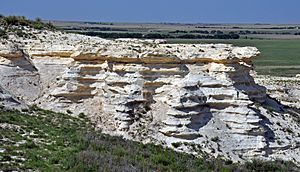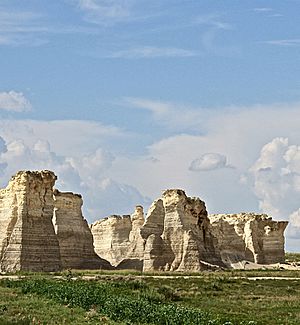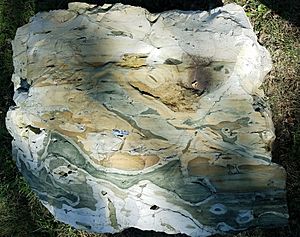Niobrara Formation facts for kids
Quick facts for kids Niobrara FormationStratigraphic range: Coniacian-Campanian |
|
|---|---|

Smoky Hill Chalk badlands, Niobrara Formation, in Kansas
|
|
| Type | Formation |
| Sub-units | Smoky Hill Chalk Member Fort Hays Limestone Member |
| Underlies | Pierre Shale |
| Overlies | Carlile Formation Or Benton Shale where the Carlile or Greenhorn Formations are not developed |
| Lithology | |
| Primary | Chalk |
| Other | Shale |
| Location | |
| Coordinates | 42°44′49″N 98°02′23″W / 42.746912°N 98.0398029°W |
| Region | North America |
| Country | |
| Type section | |
| Named for | Niobrara River, Knox Co., Nebraska |
| Named by | Meek, F.B., and Hayden, F.V. |
| Year defined | 1862 |
The Niobrara Formation, also known as the Niobrara Chalk, is a special layer of rock found in North America. It formed between 87 and 82 million years ago. This was during the Late Cretaceous period, when dinosaurs still roamed the Earth.
This rock layer is mostly made of two main parts. The top part is called the Smoky Hill Chalk Member. Below it is the Fort Hays Limestone Member. The chalk formed from tiny sea creatures called coccoliths. These creatures lived in a huge ancient ocean called the Western Interior Seaway. This sea once split North America into two parts!
Today, the Niobrara Formation lies beneath much of the Great Plains in the US and Canada. It's famous for its many fossils of ancient sea animals. These include plesiosaurs, mosasaurs, and pterosaurs. Even some early aquatic birds have been found here. The first place where the Niobrara Chalk was officially studied is near the Niobrara River in Knox County, Nebraska.
Contents
Exploring the Niobrara Formation
Scientists first wrote about the Niobrara Chalk in 1857. It was officially named in 1862 by F.B. Meek and F.V. Hayden.
The first big studies of the Niobrara Chalk began in 1870. Othniel Charles Marsh from Yale University led these early trips. His teams found the very first fossil bones from this rock layer. More expeditions happened in 1871 and 1872.
Professional fossil hunters like B. F. Mudge and S. W. Williston also helped. They continued digging for fossils until 1879.
People have kept exploring the Niobrara Chalk ever since. H. T. Martin from the University of Kansas found many specimens. So did George F. Sternberg, whose father was a famous fossil collector. Many of the best fossils from the Niobrara Formation are now on display. You can see them at the Sternberg Museum of Natural History in Hays, Kansas.
Layers of the Niobrara Chalk
The Niobrara Formation is made of different rock layers. Scientists call this "stratigraphy." The Smoky Hill Chalk Member holds most of the fossils. It's divided into 23 smaller layers, like pages in a book. Most of the large animal fossils come from the upper half of this member.
Early fossil hunters often described bones as being from "gray-blue shale" or "yellow chalk" layers. At first, they thought these were different rock units. But now we know it's just how the rock looks after being exposed to weather. The same rock can look different depending on how it has weathered.
The other main part is the Fort Hays Limestone Member. This layer is made of harder, thick limestone beds.
The Niobrara Formation sits below another marine rock layer called the Pierre Shale. Below the Niobrara, you'll find the Carlile Shale or the Benton Shale.
Ancient Sea Life
When the Niobrara Chalk was forming, the Western Interior Seaway was full of life. This was during the Late Cretaceous period. Many new types of creatures appeared then, like the huge mosasaurs. These were some of the last big sea reptiles to evolve before the end of the Mesozoic Era.
The types of animals found in the Niobrara Chalk are similar to those in the Dakota Formation. However, the Dakota Formation is about 10 million years older. It formed during the Cenomanian stage of the Cretaceous.
Cool Rocks and Energy
The Niobrara Chalk is useful for more than just fossils! In some places, the Niobrara Chalk was covered by other sediments. This caused parts of it to turn into a hard, glassy material. This material is called Smoky Hill Jasper or Niobrarite. Early humans on the High Plains used these rocks to make stone tools.
Today, the Niobrara Formation is also important for energy. It holds natural gas in some areas, like the eastern Denver Basin. Oil is also found in the Niobrara in places like the North Park Basin. New drilling methods are helping us get more oil from these rocks.
The Fort Hays member of the Niobrara was also used in the past. People quarried it (dug it out) to make Portland cement. This happened in towns like Superior, Nebraska and Yocemento, Kansas. It was also quarried along the Dakota Hogback in Colorado. One company in Yankton, South Dakota even supplied cement from the Niobrara for the Panama Canal project!




